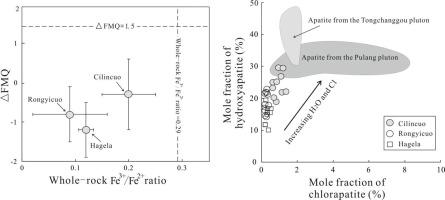Ore Geology Reviews ( IF 3.2 ) Pub Date : 2021-09-23 , DOI: 10.1016/j.oregeorev.2021.104494 Li-Chuan Pan 1 , Rui-Zhong Hu 1, 2 , Xin-Song Wang 1 , Xian-Wu Bi 1 , Jing-Jing Zhu 1 , Shan-ling Fu 1 , Jun Yan 1 , Yong Wang 3

|
The Yidun Cu-Mo polymetallic metallogenic belt, located in the eastern Tibetan Plateau, is well known for numerous Mesozoic porphyry Cu–Mo deposits. The Cu-Mo deposits are only concentrated in the southern part of the belt while the granites situated in the north are generally barren in Cu-Mo mineralization. To understand the cause of Cu and Mo infertility, geochronology and petro-mineral geochemistry of three Cu- and Mo-barren granite plutons (Cilincuo, Rongyicuo, and Hagela) in the Northern Yidun Terrane were investigated. Petrogeochemical characteristics and zircon U-Pb dating (95–85 Ma) along with the tectonic evolution history confirmed that the three plutons formed in a Late Cretaceous intracontinental setting. The whole-rock geochemical compositions showed that these plutons can be classified as A-type granites and have undergone extensive magmatic differentiation. Based on the calculated magmatic oxygen fugacity using zircon composition and a set of geochemical criteria including whole-rock Sr/Y ratios, Eu/Eu* and Fe3+/Fe2+ values as well as apatite Cl-H2O contents, the parental magma of the Cilincuo pluton was identified as more oxidized and H2O-Cl-rich than those of the Rongyicuo and Hagela plutons. These features enable the Cilincuo pluton to have an elevated capacity of Cu mineralization compared to the other two plutons. However, the causative magmas of the three plutons are still not enough hydrous and oxidized for typical porphyry Cu ± Mo mineralization. The whole-rock Sr-Nd isotope values of these three plutons are consistent with Late Triassic Cu and Mo barren granites in the same region such as Dongcuo, Cuojiaoma and Sucuoma, suggesting that they were derived from a similar magma source which might lack the oxidized and hydrous Neoproterozoic arc root remnant.
中文翻译:

铜钼贫瘠花岗岩: 来自青藏高原东部义墩地北晚白垩世岩体的洞察
伊顿铜钼多金属成矿带位于青藏高原东部,以众多中生代斑岩铜钼矿床而闻名。Cu-Mo矿床仅集中在带南部,而北部的花岗岩一般贫瘠Cu-Mo矿化。为了解铜钼贫瘠的成因,研究了北宜墩地块三块铜、钼贫瘠花岗岩岩体(茨林措、荣义措和哈格拉)的年代学和岩石矿物地球化学。岩石地球化学特征和锆石 U-Pb 定年(95-85 Ma)以及构造演化历史证实,这三个岩体形成于晚白垩世的陆内环境。全岩地球化学成分表明,这些岩体属于A型花岗岩,经历了广泛的岩浆分异。基于使用锆石成分计算的岩浆氧逸度和一组地球化学标准,包括全岩 Sr/Y 比、Eu/Eu* 和 Fe3+ /Fe 2+值以及磷灰石Cl-H 2 O 含量,确定茨林措岩体母岩浆氧化程度更高,H 2O-Cl 比荣益措和 Hagela 岩体中的富 O-Cl。与其他两个岩体相比,这些特征使芝林措岩体具有更高的铜矿化能力。然而,这三个岩体的成因岩浆仍然没有足够的水合和氧化作用来形成典型的斑岩铜±钼矿化。这三个岩体的全岩 Sr-Nd 同位素值与东措、错角马和苏措马等同一地区晚三叠世的铜和钼贫瘠花岗岩一致,表明它们来源于相似的岩浆源,可能缺乏氧化作用。和含水的新元古代弧根残余。











































 京公网安备 11010802027423号
京公网安备 11010802027423号